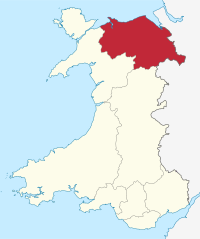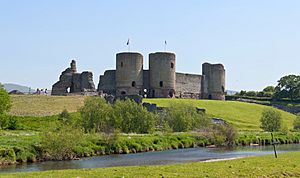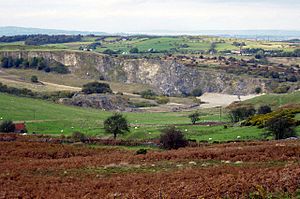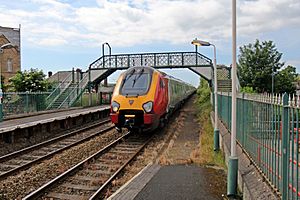Clwyd facts for kids
| Clwyd | |
|
|
|
| Geography | |
| Status | Non-metropolitan county (1974–1996) Preserved county (1996–) |
| 2022 area | 2,906 km2 (4th) |
| HQ | Shire Hall, Mold |
| History | |
| Created | 1974 |
| Abolished | 1996 |
| Succeeded by | Flintshire Wrexham County Borough Denbighshire Parts of Conwy County Borough Parts of Powys |
| 2022 population | 501,561 (2nd) |
Quick facts for kids Politics |
|
|---|---|
| Governance | Clwyd County Council |
 |
|
Clwyd (pronounced KLOO-id) is a special area in the northeast part of Wales. It's called a preserved county, which means its name is kept for certain official jobs, even though it doesn't have its own local government council anymore. The area is named after the River Clwyd, which flows through it.
To the north of Clwyd is the Irish Sea. To the east, it borders the English areas of Cheshire and Shropshire. To the south and west, it touches other Welsh areas called Powys and Gwynedd. Clwyd also shares a water border with Merseyside along the River Dee.
From 1974 to 1996, Clwyd was a county with its own council. This council shared local government duties with six smaller district councils. In 1996, Clwyd as a county was officially ended. New local areas were created: Conwy County Borough, Denbighshire, Flintshire and Wrexham County Borough. But the name "Clwyd" was kept for special purposes, like for the Lord Lieutenant of Clwyd, who is the King's representative.
People have lived in this part of North Wales for a very long time, since before recorded history. The Romans built a fort here. Later, the Normans and the Welsh fought over the land, building castles as they moved back and forth. Eventually, Edward I conquered Wales in 1282. In 1535, a law made Wales part of the English Crown and subject to English laws.
For a long time, farming was the main way people made a living in Clwyd. But during the Industrial Revolution, the North Wales Coalfield opened up. This led to industries growing in eastern Clwyd, especially around the Dee estuary and Wrexham. When the railway arrived in the mid-1800s, it became easy for people from cities like Lancashire and Cheshire to visit the seaside towns of North Wales.
Contents
Exploring Clwyd's Past: A Brief History
North Wales has been home to people since ancient times. When the Romans arrived in Britain, the Celtic Deceangli tribe lived in the area now known as Clwyd. They built forts on hills in the Clwydian Range. Their main town was Canovium, near an important crossing of the River Conwy. The Romans took control of this area around AD 75, and soon all of Wales was under their rule.
After the Romans left Britain in AD 410, the kingdoms of Gwynedd and Powys took over. Around 800 AD, Rhodri Mawr inherited both Gwynedd and Powys. After he died, his kingdom was divided among his three sons. This led to more fighting, not just between Welsh groups, but also with raids from Danes and Saxons.

The Norman conquest of England didn't immediately change North Wales. But this began to shift in the 13th century when the city of Chester became a base for attacks on Wales. The flat coastal area of Clwyd was the main path for these invasions. Many castles were built there to help the invaders. Castles like Flint and Rhuddlan were among the first built by Edward I of England during his successful conquest in 1282. After this, the Welsh princes no longer ruled, and Wales became part of England.
From 1216 to 1536, this area was known as the Principality of Wales. From 1301, the English Crown's lands in north and west Wales were given to the heir to the throne, who was called the "Prince of Wales." In 1535, the Laws in Wales Act 1535 officially made Wales a permanent part of the English Crown, following English law.
While many rural parts of Clwyd were not greatly changed by the Industrial Revolution, there was a lot of industry in the North Wales Coalfield, especially near Wrexham. The Bersham Ironworks in this area was very advanced. It was known for John Wilkinson, who invented new ways to make cannons. The Williams-Wynn family, who owned large estates in Clwyd, became very rich after the monasteries were closed. Their lands had valuable resources like lead, tin, copper, corn, and timber.
What is Clwyd's Geography Like?
Clwyd is located in the northeast corner of Wales. The Irish Sea is to its north. To the west is Gwynedd, and to the south is Powys. To the southeast and east, it borders the English areas of Shropshire and Cheshire. Much of the eastern border follows the River Dee and its wide mouth. Other big rivers in the area include the River Alyn (which flows into the Dee), the River Clwyd, and the River Conwy in the west.
The northern coast is very popular for tourism. It has many resorts like Llandudno, Colwyn Bay, Colwyn, Abergele, Rhyl and Prestatyn. In the northeast, you'll find Deeside, a flat coastal area near the Dee estuary. This part of Clwyd has a lot of industry. The areas around Wrexham and the towns near Chester, where people live and travel to work, are also very built up.
West of these developed areas is a chain of mountains called the Clwydian Range. These hills have a steep slope on their western side. The highest point is Moel Famau, which is about 555 meters (1,820 feet) tall. The middle part of northern Clwyd is the wide Vale of Clwyd, which has the best land for farming. South of this, the land becomes much higher and rougher, with areas like the Denbigh Moors and the Berwyn range. The central and western parts of Clwyd are much more rural than the coast and the east. Part of the Snowdonia National Park is in the western area. In 2007, the population was estimated to be around 491,100 people.
Since 2003, Clwyd's coastline stretches from the Dee Estuary in Flintshire all the way to Llanfairfechan. Clwyd includes all of the historic county of Flintshire and most of Denbighshire. Since 2003, it also includes the former Aberconwy district, which was historically part of Caernarfonshire, and the Edeyrnion Rural District from Merionethshire.
How Does Clwyd's Economy Work?
The way land is used in any area depends on its geology, which affects the soil. In the Clwydian Range, lead and spar minerals were once mined. Limestone was also quarried from mountains near Wrexham, like Llantysilio Mountain, Ruabon Mountain and Minera Mountain. The Minera Limeworks used to be the biggest lime quarries in North Wales. Later, stone for building roads was taken from these quarries, but they closed in 1992.
Coal mining in the North Wales Coalfield used to provide many jobs, but it stopped in the second half of the 20th century. Today, major products made in industrial east Clwyd include aircraft parts (by Airbus), engines (by Toyota), paper (by Shotton Paper), and processed steel. The port of Mostyn helps build and support offshore wind farms.
Farming, especially raising livestock, has traditionally been the main job in the central and western parts of Clwyd. There are both large and small farms, and the Vale of Clwyd has a busy dairy farming sector. Many towns have markets for livestock, and the farming industry supports businesses like farm machinery sellers, vets, and feed suppliers. As farming incomes have gone down, farmers have found new ways to earn money through tourism, local crafts, special food shops, farmers' markets, and by selling food products with added value.
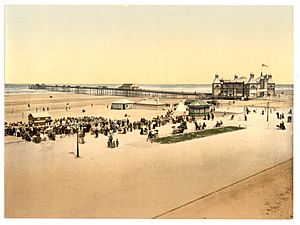
The hilly areas, with their sheep farms and small fields surrounded by stone walls, attract visitors. Old farm buildings are often turned into places for self-catering holidays, and farmhouses offer bed-and-breakfast rooms. When the railway reached the coast in the mid-1800s, it made travel from Merseyside much easier. This led to a big increase in tourism, with guesthouses in seaside towns offering rooms and meals to city visitors. More recently, caravan sites and holiday villages have become popular, and more people own "second homes" in the area.
In 2016, several projects were started to help the economy of North Wales. These include the Northern Gateway project on the former Sealand RAF site in Deeside, and a plan to redevelop the seafront and funfair in Rhyl.
How Clwyd's Government Changed Over Time
In 1958, a group called the Local Government Commission for Wales suggested combining many of Wales's administrative counties. However, the government minister at the time decided not to accept this idea because similar changes in England had been very unpopular.
In 1967, a new government minister for Wales, Cledwyn Hughes, brought back the idea of combining counties. He suggested creating a single new area called Gwynedd that would include Denbighshire, Flintshire, Caernarfonshire, Merionethshire, and Anglesey. He said that changes were "particularly urgent in Wales." But people thought this new council would be too big. So, in November 1968, a new minister announced that Gwynedd would be split into two parts.
This updated plan continued in March 1970. It suggested that the councils should be "unitary authorities," meaning they would handle all local government jobs without smaller district councils below them. However, the new Conservative government, which came into power, brought back the idea of two levels of local government in February 1971, keeping the same upper-level boundaries.
After some small boundary changes, the Local Government Act 1972 officially created Clwyd. It combined Flintshire with most of Denbighshire, plus the Edeyrnion Rural District from Merionethshire. The name Clwyd was chosen in 1970, referring to the River Clwyd and the Clwydian hills. Clwyd was the only new Welsh county not named after an ancient kingdom.
For the second level of local government, Clwyd was divided into six districts: Alyn and Deeside, Colwyn, Delyn, Glyndŵr, Rhuddlan and Wrexham Maelor. Each had its own council. These districts, along with Clwyd county itself, were ended on April 1, 1996.
The Clwyd County Council was given its coat of arms in December 1974. The design includes parts from the old coats of arms of Flintshire and Denbighshire. The green and white wave on the shield stands for the Vale of Clwyd and the Clwydian Range between the two areas. The cross and birds (choughs) come from Flintshire's shield. The black lion comes from Denbighshire's shield. The motto, Tarian Cyfiawnder Duw, means "The shield of Justice is God."
The Local Government (Wales) Act 1994 ended Clwyd County Council and its districts. Local government was then taken over by four new "unitary authorities": Flintshire, Wrexham County Borough, Denbighshire, and parts of Conwy. This Act also ended the county of Clwyd. However, the Act then created a new set of "preserved counties," based on the eight counties from the 1972 Act. These preserved counties, similar to ceremonial counties in England, were kept for certain official roles, like for the King's representatives.
Clwyd County Council and its six districts stopped working on April 1, 1996. Local government immediately moved to the new areas of Conwy, Denbighshire, Flintshire, and Wrexham. Even though Flintshire and Denbighshire kept their names, their borders were very different from the historic counties. The old county records were already stored in different places, so it was easy to separate them.
The Preserved County of Clwyd started on the same day Clwyd County Council was ended. The preserved county was almost the same as the 1974–96 county, but with a few small changes. For example, the communities of Llanrhaeadr-ym-Mochnant, Llansilin and Llangedwyn moved from Clwyd to Powys.
Changes to Clwyd's Borders in 2003

In 2003, the borders of Clwyd were changed again. This was part of a big reorganization of all the preserved counties in Wales. The goal was to make sure that the borders of preserved counties matched the borders of the current main local areas.
Because of this, some areas, like the Aberconwy district, moved into the preserved county of Clwyd, even though they had never been part of it before. These changes were not widely reported because preserved counties have a limited role. The Boundary Commission decided to keep the eight preserved counties and changed their borders in 2003 to match the current local authority boundaries. This 2003 change brought towns like Llandudno and Conwy into the preserved county of Clwyd.
Clwyd's Lasting Impact
Some local groups and organizations still use the name "Clwyd" today. This is often because their members come from a wider area than just one of the current local authorities.
- Theatr Clwyd is a theater in Mold. It's the biggest arts center in Wales that creates its own shows. It also gives young people chances to get involved in drama.
- The Clwyd Family History Society helps its members find historical documents about northeast Wales.
- The Clwyd-Powys Archaeological Trust is one of four groups that study ancient sites across Wales.
- The Clwyd County Darts Association organizes dart tournaments and takes part in matches against other counties.
- The Clwyd East Football League was started in 2011 for football teams in the North East Wales area. It has since changed its name to the North East Wales Football League.
- The Clwyd Pension Fund is a pension scheme that was passed down from Clwyd County Council. It now provides pensions for workers in the Wrexham, Flintshire, and Denbighshire local authorities.
The job of Lord Lieutenant of Clwyd also continues. This person is the Monarch's personal representative, just like in the other seven preserved counties of Wales. The current Lord Lieutenant is Henry George Fetherstonhaugh, who was appointed in 2013.
Famous Places and Landmarks in Clwyd
- The Pontcysyllte Aqueduct was built by Thomas Telford in 1805. It's the largest aqueduct in the United Kingdom. It carries the Llangollen Canal over the River Dee. It's a World Heritage Site and is considered a masterpiece of engineering.
- The Clwydian Range and Dee Valley is a beautiful area known as an Area of Outstanding Natural Beauty. It's one of only five such areas in all of Wales.
- Denbigh, Colwyn, and Ruthin are historic towns.
- Llangollen hosts the Llangollen International Musical Eisteddfod every July. This is a famous festival of music and dance.
- The Gop is a very old mound built during the Neolithic period. It's the second largest structure of its kind in Britain, after Silbury Hill.
- Caer Drewyn is one of many Iron Age hill forts in Clwyd. These forts show that people have lived in this area for thousands of years.
- Maen Achwyfan Cross is a carved stone cross from the 10th century. It shows symbols from both Celtic and Viking cultures.
- The castles of Rhuddlan and Flint were built by the Normans when they invaded North Wales.
- Castell Dinas Brân was a Welsh fortress from the same time.
- St Asaph Cathedral also dates back to the 13th century, as does the medieval Cistercian abbey of Valle Crucis.
- Bodnant Garden is a beautiful formal garden set in a landscaped area.
- Erddig Hall is a grand country house. Both are owned by the National Trust.
- Other lovely country houses in Clwyd include Trevor Hall and Faenol Fawr, Bodelwyddan.
- Plas Mawr and Aberconwy House are historic townhouses in Conwy.
- Also in Conwy is the Conwy Suspension Bridge, which was one of the first bridges of its kind in the world.
How to Get Around: Transport in Clwyd
- The North Wales Coast Line is a railway line that runs from Crewe to Holyhead. Trains on this line are run by Transport for Wales and Avanti West Coast.
- Trains leave Crewe, pass through Chester, and cross the River Dee into Wales. They stop at stations like Shotton, Flint, Prestatyn, Rhyl, Colwyn Bay, Llandudno Junction, Conwy and Bangor, before reaching Holyhead. From Holyhead, you can take a ferry to Ireland.
- At Shotton, passengers can change for the Borderlands Line, which connects Wrexham to Bidston on the Wirral Peninsula in England.
- The Conwy Valley Line connects Llandudno Junction to Blaenau Ffestiniog. It passes through Betws-y-Coed. This line was mainly built to carry slate to the quay at Deganwy for export by sea. It's a very scenic route with several stops where you can ask the train to stop.
- The Shrewsbury–Chester line connects Wrexham General station northwards to Chester and southwards to other stations in the Wrexham area and to Shrewsbury.
- There are no motorways in Clwyd.
- The A55 is a dual carriageway road that goes from Chester through St Asaph to the North Wales coast at Abergele. After that, it runs next to the railway line through Conwy and Bangor, ending at Holyhead.
- The A483 connects Wrexham northwards to Chester, and southwards to Ruabon and Chirk.
- The A548 goes from Chester to Abergele through Deeside and along the coast, before turning inland and ending at Llanrwst.
- The main road from London is the A5. It enters Clwyd at Chirk and goes northwest through Llangollen, Corwen and Betws-y-Coed, joining the A55 and ending at Bangor.
- The A543 crosses the Denbigh Moors from southeast to northwest.
- The A525 connects Ruthin with St Asaph.
- There are local bus services between the main towns. Several services by Arriva Buses Wales run along the main coast road between Chester and Holyhead, connecting the coastal resorts. Other bus routes include: Llandudno to Llanrwst and Betws-y-Coed (via Conwy and Dolgarrog); Rhyl to Denbigh; Wrexham to Chester; and Wrexham to Mold.
See also
 In Spanish: Clwyd para niños
In Spanish: Clwyd para niños


